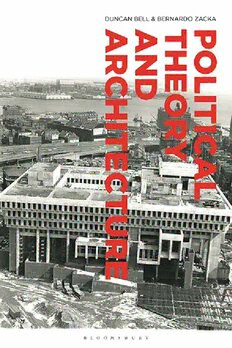Download Political Theory and Architecture PDF Free - Full Version
Download Political Theory and Architecture by Bernardo Zacka in PDF format completely FREE. No registration required, no payment needed. Get instant access to this valuable resource on PDFdrive.to!
About Political Theory and Architecture
Architecture is not merely a backdrop for political life, but an important political agent in itself. Architecture represents and symbolizes our values and enacts visions of social order; it encourages and prevents certain forms of behaviour and it shapes our everyday experiences. It is, at once, a mirror we hold up to ourselves, a site of political struggle, an instrument of power, and a vector for social change. It also lends itself to being re-appropriated in myriad ways by those who use it, its meanings and hierarchies endlessly subverted and redirected.This book situates the built environment at the heart of debates over democracy and citizenship. Does democracy call for a distinctive spatial environment, and if so, what are its characteristics and symbolism? How can architecture contribute positively to the democracy of everyday life – the ordinary patterns of interaction between citizens that engender and sustain a democratic ethos? How can architecture participate in progressive political change, deepening the democratic character of our societies, and what dilemmas does it face when it attempts to do so?The contributors to the volume approach these interdisciplinary questions, reflecting the range of methods and sensibilities that animate contemporary political theory. What emerges is a multifarious engagement with the many facets of the built environment and a sustained inquiry into their significance for democratic theory.
Detailed Information
| Author: | Bernardo Zacka |
|---|---|
| Publication Year: | 2020 |
| ISBN: | 9781350103757 |
| Pages: | 329 |
| Language: | English |
| File Size: | 3.637 |
| Format: | |
| Price: | FREE |
Safe & Secure Download - No registration required
Why Choose PDFdrive for Your Free Political Theory and Architecture Download?
- 100% Free: No hidden fees or subscriptions required for one book every day.
- No Registration: Immediate access is available without creating accounts for one book every day.
- Safe and Secure: Clean downloads without malware or viruses
- Multiple Formats: PDF, MOBI, Mpub,... optimized for all devices
- Educational Resource: Supporting knowledge sharing and learning
Frequently Asked Questions
Is it really free to download Political Theory and Architecture PDF?
Yes, on https://PDFdrive.to you can download Political Theory and Architecture by Bernardo Zacka completely free. We don't require any payment, subscription, or registration to access this PDF file. For 3 books every day.
How can I read Political Theory and Architecture on my mobile device?
After downloading Political Theory and Architecture PDF, you can open it with any PDF reader app on your phone or tablet. We recommend using Adobe Acrobat Reader, Apple Books, or Google Play Books for the best reading experience.
Is this the full version of Political Theory and Architecture?
Yes, this is the complete PDF version of Political Theory and Architecture by Bernardo Zacka. You will be able to read the entire content as in the printed version without missing any pages.
Is it legal to download Political Theory and Architecture PDF for free?
https://PDFdrive.to provides links to free educational resources available online. We do not store any files on our servers. Please be aware of copyright laws in your country before downloading.
The materials shared are intended for research, educational, and personal use in accordance with fair use principles.

